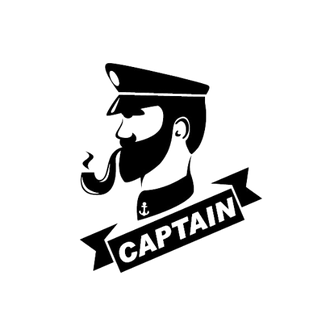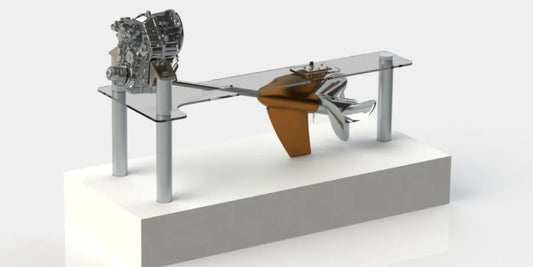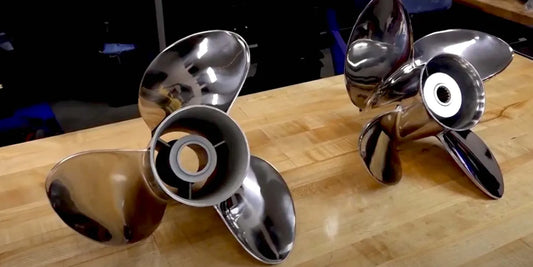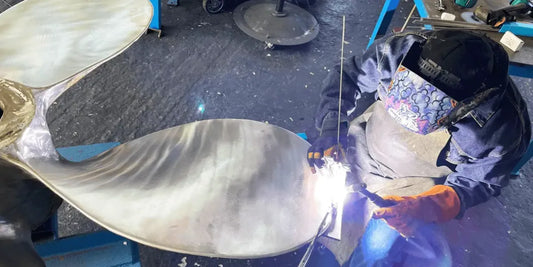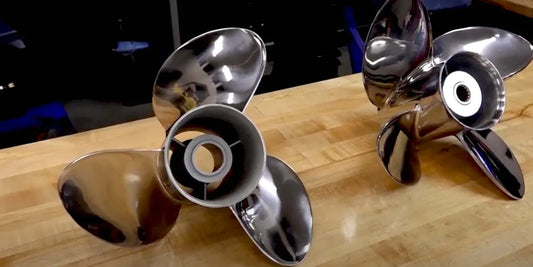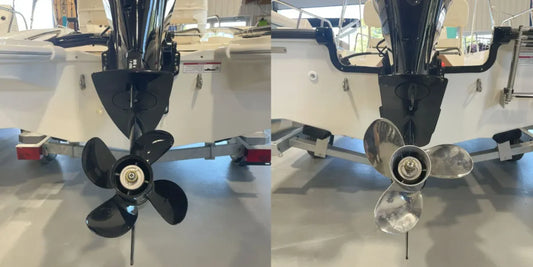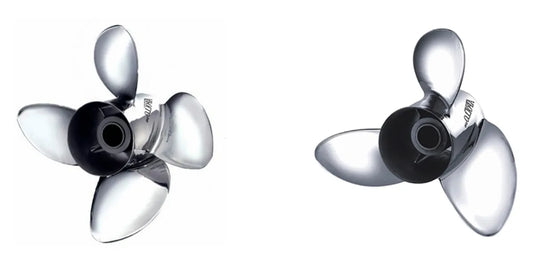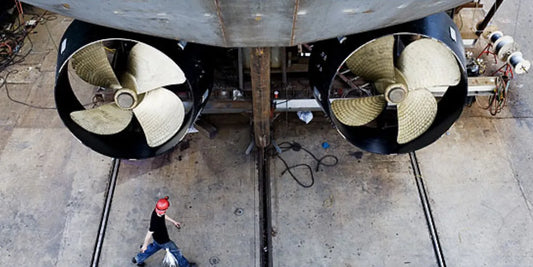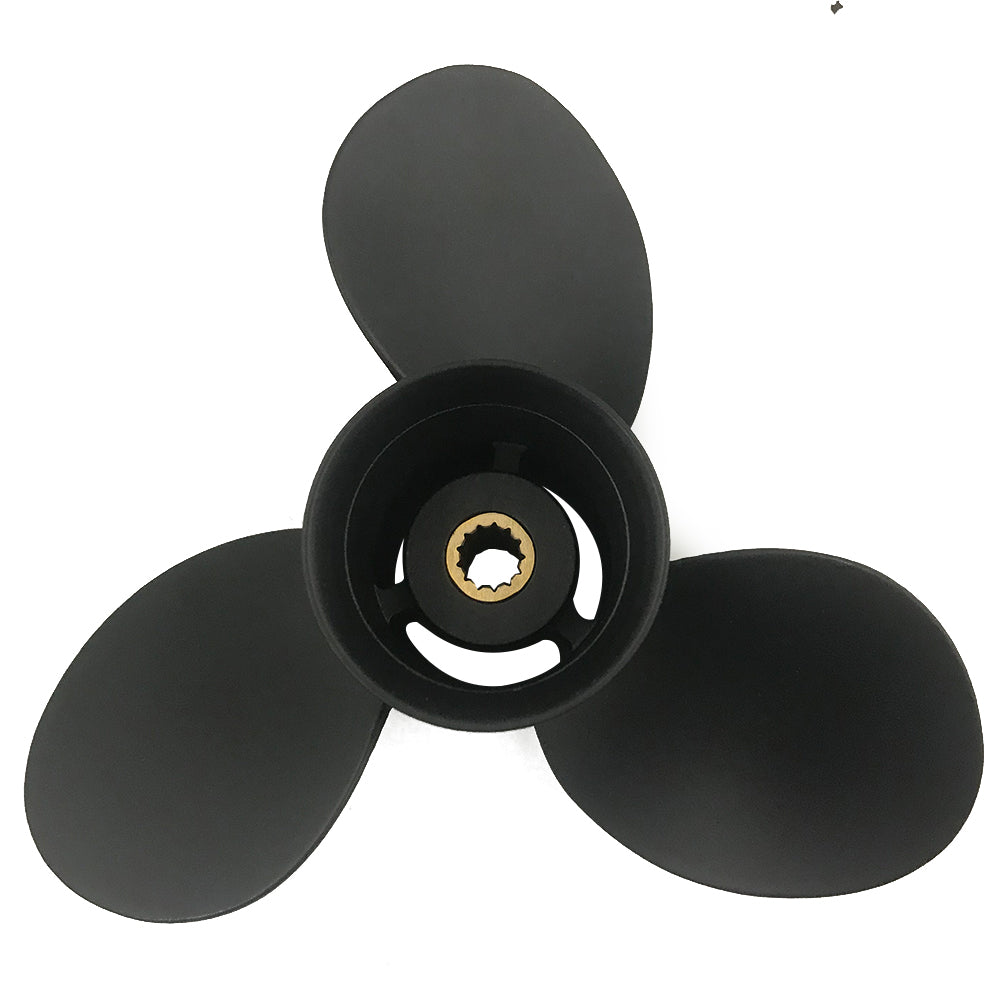Having the aluminum propeller, marine applications have long had the distinction of presenting an unusual mixture of durability, efficiency, and cost-effectiveness. Whether you're a hobbyist on the waters, a fishing professional, or even on a commercial vessel, the choice of the propeller plays a significant role in affecting performance and operational reliability. This article will highlight the features that make aluminum propellers a preferred choice for many watercraft users. We will discuss their resistance to harsh aquatic conditions, optimization of fuel efficiency, and how they compare to those on the market. From performance particulars to maintenance knowledge, this article will equip you fully to make decisions concerning what matters to you in the sea.
Introduction to Aluminum Propellers

Definition and Overview of Aluminum Propellers
Aluminum propellers serve as a vital part of marine propulsion systems, mainly fabricated from lightweight yet strong aluminum alloys. Due to their economical price, corrosion-resistant nature, and ease of production, they find applications on all types of watercraft, ranging from recreational boats to small and medium-sized commercial vessels. Aluminum propellers are relatively inexpensive, offering effective and efficient performance, as well as smooth operation, in aquatic environments.
In aluminum propellers, modern casting or forging techniques are applied, which, in theory, optimize the application of thrust against passenger drag, thereby saving fuel and allowing for increased speed. These days, engineering designs incorporate blade geometries that maximize water displacement and minimize cavitation, a phenomenon in which vapor bubbles form and collapse near the propeller, thereby resulting in wear. Aluminum propellers are very durable and feature innovations in material treatment and design that enable them to perform under conditions of frequent use or in the presence of abrasive media, such as sand or debris.
Due to their versatility and accessibility, they are regarded as the highest choice of boaters looking for a budget yet dependable propeller. While more heavy-duty materials, such as stainless steel, may outperform aluminum in the most extreme conditions, aluminum propellers retain their appeal for most recreational and moderate-use applications due to considerations of price, performance, and maintenance.
Advantages of Aluminum Use in Marine Propellers
Because they provide an uncommon juxtaposition of cheapness, performance, and reliability, aluminum propellers are well-suited for a variety of applications in the boating world. Because lightweight propellers utilize less fuel and are easier to handle on small to medium-sized boats, one of the benefits of aluminum propellers is that they fulfill a lightweight criterion. Furthermore, aluminum resists corrosion, particularly when protected by coatings, which grants extended life and reduced maintenance for propellers operating in both freshwater and saltwater environments.
Additionally, they are cost-effective. Aluminum propellers never really cost less than stainless steel, which in turn can come as an advantage to boaters who are mindful of budgets or those needing a quick replacement. In exchange for their cost-effectiveness, they offer a sufficient balance between durability and performance for leisure boating, fishing, or family outings.
Another vital feature for repairability. The aluminum propeller, being softer, can be repaired in some cases if it is dented or damaged, thereby avoiding complete replacement. On the strength side, however, modern aluminum alloys are engineered for great strength while maintaining a sufficient degree of flexibility to withstand impacts from contact or underwater obstacles; these features enhance confidence and satisfaction for users.
Comparison with Other Materials
When aluminum, stainless steel, carbon fiber, or composite propellers are placed side by side, a few notable differences emerge. The propellers of stainless steel are considered the most robust and durable among all, ideally suited for high-performance uses where speed and precision matter, as their rigidity causes less flexing at higher RPMs. However, the very rare stainless steel propellers are almost prohibitively expensive; along with that, they lack some flex points, and thus, higher damage to both the propellers and engine may be encountered in a sudden obstacle attack.
Carbon fiber and composite propellers, meanwhile, make a name for themselves with their feather-light weight and corrosion resistance. These features become pristine selling points if the environment is a saltwater one. Now, they may, however, lack the strength to withstand repeated impacts or load-bearing duties, thereby making them less robust in some cases compared to aluminum.
The tubular aluminum school setups modernized the balance between cost, performance, and serviceability. Even if aluminum could never reach the level of stainless steel's hard work or attain the unique lightness of composites, technological improvements in alloy compositions have made them so much more efficient that they are now more effectively utilized and more durable in service. This makes the aluminum type of propeller most appealing for the non-professional user and recreational boater who desires dependable performance at costs that are not overbearing.
Types of Aluminum Propellers

3-Blade Aluminum Propellers
The 3-blade aluminum propellers are the most common, maintaining a balance of speed, acceleration, and fuel efficiency. These propellers feature three blades to enhance propulsion by reducing drag while preserving stability in various water conditions. In contrast, they are used for general use and recreational boating purposes, providing good vessel performance at a moderately affordable price.
Given their working mechanisms, 3-blade propellers offer the best efficiency at mid- to high-speed operations; therefore, they are well-suited for activities such as water skiing and casual cruising. Further advances in blade geometry and alloy chemistry now enable enhanced life expectancy through increased resistance to corrosion and wear in saltwater applications. 3-blade aluminum propellers offer the average boater the best balance of performance and price, making them suitable for almost any condition and type of vessel.
Black Max Aluminum Propellers
Boat users wishing for a propeller that offers a combination of performance, affordability, and reliability are in luck with Black Max aluminum propellers. Designed with a keen eye for detail, the propellers cater to everyday boating activities, ensuring predictable performance in varying water conditions. These three blades are designed to provide incredible acceleration with minimal drag and friction, from cruising speeds to a range of slower speeds. This makes a perfect general-purpose product usable by those who merely enjoy cruising while still giving the precise control needed for towing sports like tubing and wakeboarding.
Built from strong aluminum alloy with the latest paint coating, these Black Max propellers are designed to withstand years of exposure to harsh marine environments and corrosive conditions, making them highly effective in saltwater applications. Furthermore, Black Max propellers are readily installed on various types of Mercury engines, making them very convenient for both boaters and professionals alike. Pricing-wise, they are the most affordable and widely available option for anyone who wishes to enhance their vessel's performance.
Let me cite another peculiar advantage worth mentioning, namely, fuel efficiency. By maximizing the blade's slip reduction trait, Black Max aluminum propellers provide a more effective protection of fuel economy. Especially on longer journeys, where reducing consumption is a significant matter. Hence, boat owners or prospective owners who desire to replace old propellers with new ones, the Black Max series has a classic, worthy successor endorsed by one of the most reputable brands in the business. Whether you are out in the high seas or inland, Black Max propellers will grant you the power and dependability for great boating.
Specialized Aluminum Prop Designs
Specialized aluminum propellers are specifically designed to strike a delicate balance between performance, durability, and economy. Precision manufacturing techniques design these props according to various boating requirements, from small recreational fishing boats to high-speed performance crafts. Due to the lightweight nature of the design, these reduce engine strain, which enhances mileage, and also reduces handling effort.
Hydrodynamics now decides and influences aluminum propeller design with new-age modifications. Instead of using a single thrust value, the thrust becomes variable with the introduction of a cupping blade and a progressive pitch angle, affecting the tip velocity. This results in consistent acceleration and top-end speed. These also enable a better grip on the propeller in the water, making them trustworthy even in adverse situations, such as raging water currents or choppy waves. Special coatings on the aluminum surface also prevent corrosion, which extends the propeller's lifespan, especially in saltwater conditions.
With the right combination of innovation and durability, customized aluminum propellers serve a myriad of boaters, being fully versatile and offering reliable performance without a significant impact on the pocket. Whether a given design focuses on speed, control, or fuel conservation, it ultimately caters to the changing needs of modern-day boaters.
Performance and Efficiency of Aluminum Propellers

Impact on Engine Performance
Aluminum propellers have a direct impact on engine optimization due to their lighter weight and adjustability. The lesser the weight of a propeller applied to the engine, the better it is for the engine's stamina, and the result is enhanced fuel efficiency and extended engine durability. Studies show aluminum propellers may reduce fuel consumption by up to 10%, thus presenting a very affordable choice for people who frequently use boats. Pitch adjustments can be made to a great extent with these propellers to fit any type of engine, thus offering more effective thrust.
Recent advancements in aluminum technology have improved heat dissipation and resistance to deformation, enabling consistent engine operation even in moderately demanding conditions. Such developments enhance better handling, acceleration, and vessel control, as required by both recreational and commercial operators. Precision engineering and durable materials combined have ensured that the speed aluminum propellers impart on waterward engines is always dependable and efficient.
Efficiency in Various Marine Conditions
Aluminum propellers are an excellent choice for various marine environments that require versatility and performance during navigation. The propellers are so light and structurally precise that they consistently yield the same performance, whether the boat is in calm waters inside a freshwater lake or in choppier offshore conditions. For instance, aluminum propellers are designed specifically for corrosion resistance in both freshwater and saltwater, providing long-term durability and a dependable boating experience. The advanced contours of the latest aluminum propeller blades optimize thrust while minimizing drag, enabling vessels to maximize fuel efficiency and speed, even in rocky waters.
Marvelously capable of adjusting to the changes in load and other intermittent fluctuations in water depth, aluminum propellers perform well under such varying circumstances. This is because the propeller design minimizes cavitation and slippage, which occur more frequently in environments where the water changes with acceleration due to a light cargo or steady-state conditions with a heavy load. The consistent performance also means less wear and tear to the engines, better fuel economy, and thus, cost efficiency for both marine lovers and the trade. Aluminum propellers are a perfect example of excellent engineering combined with endless capability, making them useful regardless of the strain imposed by varying marine conditions.
Aluminum vs. Stainless Steel Propellers
When deciding between aluminum and stainless steel propellers, it makes sense to weigh their characteristics and performance. Aluminum propellers are described as inexpensive and versatile by the trade. Aluminum propellers are lightweight, easy to repair, and suitable for boats in smoother, less demanding waters. The aluminum propeller is therefore preferred by the occasional boater or those who operate small crafts—that is, those who want to spend very little but do want to get as much function out of the product as possible.
Metal, on the other hand, stainless steel propellers are famous for being sturdy, durable, and sturdy. In situations of high performance, such as high engine output and difficult marine circumstances, they perform better. They resist deformation well enough to provide a consistent level of production, regardless of speed or heavy load. Although stainless steel propellers bear a higher upfront cost, their lifespan and rarity of requiring replacements, as well as their fuel efficiency, usually offset any such initial cost, especially in serious professional and marine usage.
The choice will depend on the usage conditions, further budgetary considerations, and expectations regarding performance. Aluminum propellers are best suited for individuals who value versatility and low cost. Stainless steel, on the other hand, offers superior performance and durability for situations that require premium-grade reliability in the water.
Maintenance and Care for Aluminum Propellers

Regular Inspection and Cleaning
Fitted maintenance on aluminum propellers ensures their efficiency, serviceability, and optimal performance. Proper inspection must be an absolute priority well ahead of, and most especially after, every boat trip; damage worthy of consideration includes cracks, bends, or excessive wear that may argue for ill effect on performance and safety. Mariners must keep their eyes on the edges of the blades and the hub, for these are most typical areas of damage resulting from the collisions with debris or underwater obstacles. Early detection of these problems can save you from major mechanical failures and exorbitant repair bills.
Cleaning aluminum propellers is another critical maintenance act. Once in use, the propeller should be thoroughly rinsed with freshwater to remove salt, dirt, and any other corrosive materials that may have accumulated over time, especially after use in saltwater conditions. For stronger contaminants, a mild detergent and soft brush may be used to clean the propeller, provided the surface is not scratched. An anti-corrosive spray for marine purposes can also be applied to provide additional protection against rust and pitting. Such tricks lengthen the lifespan of your propeller and make for a smoother and more reliable boating experience.
Remember, regular care and complete maintenance will extend the lifespan of aluminum propellers, securing your investment in your boat. By staying proactive, boat owners can circumvent frustration and maximize their enjoyment time.
Common Issues and Fixes
Scratches and Nicks in Propeller Blades
Issue: Small debris or underwater obstacles can bruise and nick aluminum propeller blades, reducing efficiency and increasing fuel consumption.
Fix: Inspect the blades for visible damage on a regular basis. Slight nicks might be filed down or sanded with fine sandpaper. In the case of bigger damages, seek the assistance of a professional repair service or contemplate the replacement of the propeller if severe enough.
Propeller Cavitation
Issue: Cavitation occurs when air bubbles form around the propeller, reducing thrust and causing vibrations that may erode the blade surface. Improper sizing of the propeller, damage to the blades, or excess speed is often the root cause.
Fix: Check the propeller size to ensure it is appropriate for the engine and boat combination. Get any blade damage repaired immediately, and never operate the engine at excessive revolutions.
Corrosion in Saltwater Environments
Issue: Exposure to saltwater for extended periods leads to corrosion of the aluminum propellers that, over time, compromises their structural integrity.
Fix: Rinse the propeller in clean water every time after it touches the saltwater, so that salt deposits do not build up on it. Apply an anti-corrosion spray specifically designed for marine use, and ensure that the protective coating on the propeller remains intact.
Imbalance or Vibration During Operation
Issue: This vibration arises from either uneven wear of the propeller or other causes, such as blade deformation or improper installation.
Fix: Ensure that the propeller has been firmly installed and aligned correctly. Should the imbalance persist, have your propeller rebalanced at a repair shop. Inspection during regular maintenance prevents this.
Speed and Performance Reduction
Issue: The speed and performance of the propeller diminish due to wear and tear or improper care.
Fix: Inspect for wear, chipped paint, and dents on the propeller. Remove marine growth or debris from the propeller. If deterioration is substantial, sharpening or replacement shall ensure optimal performance.
It is recommended to regularly check, clean, and address common problems to extend the life of aluminum propellers and perform these tasks with sufficient efficiency.
Longevity and Replacement Considerations
Maximizing the propeller's life requires a good balance between maintenance and timely replacement. Depending on usage, operating conditions, and exposure to corrosive environments, normally serviced aluminum propellers tend to last around three to five years. There should be regular inspections for nicks, cracks, or bent blades, as such minor damage can be inefficient and wear off more quickly with usage.
Signs of replacement include, for instance, a decrease in fuel efficiency, increased vibration, or difficulty in maintaining ideal speed. New propellers made of more advanced materials and designs are worthy of purchase, as they typically offer better performance, improved fuel economy, and enhanced running characteristics. In choosing the propeller best suited to the actual engine specification of the boat and the intended use, maximum advantage is ensured, ensuring a good fit and optimal function at peak efficiency.
Cost Analysis of Aluminum Propellers

Price Range of Aluminum Propellers
The aluminum propeller tends to be a relatively inexpensive item, considering the price range, whereas the stainless steel propeller is more expensive. Aluminum propellers range in price from $100 to $300, depending on size, brand, and the level of performance required. The lower-priced ones work great for casual boaters or smaller engines. These propellers are priced to fit standard use, making them the most popular choice among budget setters.
Upgraded designs or finishes targeted towards enhancing performance and durability typically characterize aluminum props well into the $300 range. They might be endowed with features such as a variable pitch or special corrosion-resistant coatings, the latter being particularly effective in saltwater environments. While more expensive, their greater efficiency and longevity make them worthy of consideration for boat owners who are intent on reducing their fuel costs or at least want to explore options for a smoother ride.
In my opinion, aluminum propellers represent a good balance between price and functionality. Most boaters can afford this price, and it also offers reliable performance across a wide range of watercraft. Having the right propeller installed for your unique needs can significantly impact the handling properties of your boat and the sensation in the water. Aluminum options are indeed flexible enough to offer this without putting a heavy dent in your budget.
Factors Influencing the Cost
Several factors determine propeller costs, and understanding these can help a prospective buyer make a more informed decision. The material is one of those major pricing factors. Aluminum, for instance, typically sells for a lower price than stainless steel but may not withstand rougher conditions or high-performance applications as well. On the contrary, stainless steel propellers are pricier because they are very durable and can withstand heavy use over a long period, a factor that some boat owners regard as a long-term investment.
Other factors lie in the size and layout of the propeller. Large propellers with a wide variety of designs, such as cupping or complex blade shapes, are priced multiple times due to their reputation and manufacturing. Additionally, price-wise, the number of blades is essential; more blades typically require more material and engineering to achieve the higher level of performance. In any case, the size and features of a propeller should be optimized to work best with the boat engine and the way the boat will be used, even if that means spending a little more initially.
Lastly, brand reputation and warranty offerings also affect overall cost. Those brands with an established reputation for quality often command a premium, but with assuredly good products and service, they give consumers a sense of security. Extended warranties or performance guarantees may be offered by some manufacturers to enhance the value of a purchase, thereby justifying a higher price tag. I strike a balance between long-term performance and my needs to ultimately select a prop that satisfies my requirements without unnecessary overspending.
Cost-Effectiveness Compared to Alternatives
Consider the big picture when evaluating cost-effectiveness. Sometimes, cheaper alternatives may carry with them trade-offs in durability, performance, and even long-term costs. By investing in a higher-quality product, whether legitimate or alternative, a premium propeller, as an upfront cost, you save in the long run from constant replacement and/or repairs. For example, a well-made and sturdy propeller lasts longer. It performs more efficiently than one with faulty craftsmanship and design, resulting in fuel savings and lower operating costs over time.
Alternatives are evaluated and weighed for opportunities in the same manner. Honestly speaking, some affordable options might be sufficient for less demanding applications or occasional use, and these alternatives do offer decent results for the minimal investment they require. These alternatives are accepted in situations with smaller budgets or those that do not require longevity. I've often found that these sometimes shortchange performance or warranty support, and if something does go wrong unexpectedly, it could result in a higher expense.
For me, the bottom line is first comprehensively to analyze one's requirements and ROI with decency. By considering long-term advantages, such as ongoing performance or reduced downtime, versus a higher upfront cost, you essentially make a price-to-value ratio decision where both sides benefit. It's actually "good but cheap," a real middle ground, rather than trading so-called cheap for price at the expense of quality.
Reference Sources
- The Ultimate Guide to Choosing Between Aluminum and Stainless Steel Propellers
- Should You Choose Stainless Steel or Aluminum Boat Props?
- Aluminum Boat Propellers | Durable & Efficient - TBNation
- Comparing Stainless Steel and Aluminum Propellers
- Is an Aluminum or Stainless Steel Propeller Right For You?
Frequently Asked Questions (FAQs)
What sets aluminum and stainless boat propellers apart?
Aluminum propellers are generally less expensive and are thus preferred by recreational boaters. Stainless steel propellers are stronger and offer better performance at high speeds. In terms of applications requiring durability and corrosion resistance, stainless steel propellers are at the forefront. Aluminum, however, is light and relatively easy to repair, which can be a plus if you need to carry out a quick fix while out on the water. Of course, aluminum propellers can also perform exceptionally well, especially in situations where lower horsepower is involved. In essence, your particular needs and budget should determine the choice between aluminum and stainless.
What factors affect the performance of an aluminum propeller?
As the old saying goes, pitch, diameter, and blade design all influence the performance of the aluminum propeller. Increasing pitch accommodates acceleration and speed but decreases handling and hole shot. Increasing the number of blades can increase speed or provide more lift. When selecting aluminum propellers, consider the motor horsepower and intended use, which may be for recreational cruising or water skiing. Quality must be maintained while giving the best performance and value.
Which is the best aluminum prop for my boat motor?
The best aluminum propeller for a boat motor depends on various factors, including the type of boat, the motor's horsepower, and the boat's intended use. The lower the pitch of a prop, the more acceleration it generally provides. A higher pitch may yield greater speed. Mercury Marine carries a wide selection of aluminum props for various outboards and uses. Also worth evaluating is the blade design and the overall quality of the prop to ensure it meets the performance requirements. Additionally, consulting with your local dealer or a propeller specialist may provide valuable information and offer helpful advice.
How do I determine the pitch of my aluminum propeller?
It might be said that your aluminum propeller needs to have the correct pitch according to the performance requirements of your boat. Pitch defines how many gallons of water are theoretically displaced by the propeller through one rotation and determines speed and acceleration. A low pitch provides better hole shot and acceleration, making it very good for water sports. In contrast, a higher pitch can offer better top-end speed but sacrifices low-end performance. Check different pitches to determine what works best and to achieve the optimal setup for your specific boat and motor. You also need to consider factors such as load and water conditions, as these can impact propeller performance. Most boat owners would attest to the fact that pitch adjustments can bring about significant improvement in the handling and efficiency of their boats.
Is it possible to repair an aluminum propeller, and if so, how?
And quite often, aluminum propellers can be repaired, which makes them desirable in contrast to stainless steel ones. Dings, dents, and bent blades are examples of damage that a technician or enthusiast can repair. Repairing an aluminum propeller typically involves straightening the blades and filling the gouges with a suitable filler material. When the prop is corrected adequately, its efficiency is increased, accompanied by an extended lifespan. If the damage becomes extreme or if the prop loses its rigidity, then perhaps replacing it is the better alternative. It is always advisable to check alignment and balance after any repairs are completed.
What should I look for when purchasing an aluminum propeller?
When purchasing an aluminum propeller, consider a few key factors to ensure it meets your specific needs. If the pitch and diameter may alter the speed and handling of your boat, look there first. Select the design that best suits your needs, whether for recreational cruising or engaging in water sports. Check the quality aspects; an aluminum prop should not bend easily, while also providing sufficient strength and durability. Look for ratings and reviews by fellow boaters on the performance and reliability of that particular prop. Lastly, ensure that the prop fits your outboard motor very well; otherwise, issues for installation and operation will arise.
